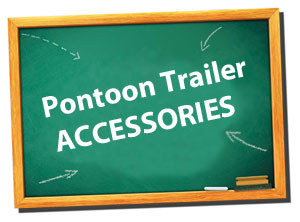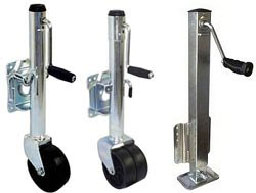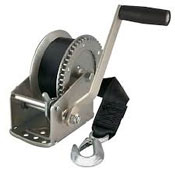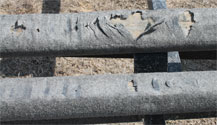 HOME |
|||
Pontoon Trailer Accessories |
|||
|
New pontoon trailers come
with a number of accessories
as standard features on the
trailer. Tongue jacks,
winches, bunk carpet,
sometimes load guides, and
of course tires, which I’ve
covered elsewhere. If you think you’re buying a quality trailer, you may get marginal accessories. Many trailer manufacturers use the same tongue jacks, winches, and bunk carpeting for all the trailers they build. The requirements can be different from a 2000 lb. single axle pontoon trailer versus a 5000 lb. trailer for a triple tube pontoon with an I/O engine, but you may get the same jack, winch, and bunk carpet. |
|||
 Tongue
Jacks Most pontoon trailers
come standard with a single
wheel “swing away” 1000-1200
lb. tongue jack. This item
is a commodity in the marine
industry and costs the
trailer manufacturer about
$20. Dealers can buy them
for about $28 and you can
buy them retail from Harbor
Freight or Northern Tool for
about $40. The jack is rated
by the capacity it will
lift. Few trailers have more
than a couple hundred pounds
of tongue weight so in
theory the cheapest tongue
jack will work on most
pontoon trailers. A few
manufacturers use a dual
wheel tongue jack, usually
with an increased capacity.
Custom manufacturers may
offer a high quality
“expensive” tongue jack. The
thing that destroys tongue
jacks is not lifting the
trailer onto the tow ball,
it’s the tow vehicle backing
into the trailer tongue and
jarring the tongue jack.
Single wheel jacks sink into
the dirt and can bend when
the top of the tow vehicle
trailer ball hits it. You
have less chance of damage
with a dual wheel jack. The
good news is tongue jacks
are not very expensive to
replace but if you have a
chance to upgrade from a
single wheel to a dual wheel
at a price difference of
less than $40 (the price of
a replacement jack) it’s a
good idea. Tongue
Jacks Most pontoon trailers
come standard with a single
wheel “swing away” 1000-1200
lb. tongue jack. This item
is a commodity in the marine
industry and costs the
trailer manufacturer about
$20. Dealers can buy them
for about $28 and you can
buy them retail from Harbor
Freight or Northern Tool for
about $40. The jack is rated
by the capacity it will
lift. Few trailers have more
than a couple hundred pounds
of tongue weight so in
theory the cheapest tongue
jack will work on most
pontoon trailers. A few
manufacturers use a dual
wheel tongue jack, usually
with an increased capacity.
Custom manufacturers may
offer a high quality
“expensive” tongue jack. The
thing that destroys tongue
jacks is not lifting the
trailer onto the tow ball,
it’s the tow vehicle backing
into the trailer tongue and
jarring the tongue jack.
Single wheel jacks sink into
the dirt and can bend when
the top of the tow vehicle
trailer ball hits it. You
have less chance of damage
with a dual wheel jack. The
good news is tongue jacks
are not very expensive to
replace but if you have a
chance to upgrade from a
single wheel to a dual wheel
at a price difference of
less than $40 (the price of
a replacement jack) it’s a
good idea. |
|||
 Front Loading Trailer Winches Like tongue jacks, most pontoon trailers come with a front loading winch and strap with a hook to pull your boat onto the trailer. Many winches are 1200 lb. capacity. They are a throw back to the days when pontoons weighed 1500 lbs. If you have a 1500 lb. boat partially floating, a winch with 1200 lb. capacity will probably pull it onto the trailer. If you have a 4000 lb. boat, the 1200 lb. winch will fail in a short time. Reputable manufacturers will replace the broken winch with a new one, often the same capacity. If you bought your trailer on e-Bay or Craig’s List, you’re probably going to get a 1200 lb. winch. Better manufacturers offer bigger winches (1500-1700 lb.) and if you have a big boat it’s important to know what you’re getting. |
|||
 Load Guides The benefits of load or wind guides are covered elsewhere. Some companies have them as standard equipment while others sell them as options. The important thing about load guides is that they should be sacrificial. That is, you want a load guide that is strong enough to nudge your pontoon tube onto the trailer, but weak enough that it will collapse or break should you hit too hard. Another benefit is if the load guide is angled back to prevent damage to pontoon spray fins. Spray fins are often just tack welded onto the pontoon tube. Load guides that are angled back help prevent contact with spray fins. A broken load guide might cost you $50. A hole in your pontoon tube from a strong load guide that didn’t break might cost you $2,000. |
|||
 Bunk
Carpeting The wooden
bunks on your pontoon
trailer will be covered with
“something” resembling
carpet. The smaller the
trailer manufacturer the
better chance you have of
getting “good” carpeting. If
the pontoon trailer
manufacturer makes fishing
boat trailers you’ll
probably get “felt” style
bunk carpeting. It’s
inexpensive and contours
easily around the wood. It
works well for 600 lb.
fishing boats floating on
and off the trailer. It
shreds or tears easily with
a 2000-4000 lb. pontoon
sliding on and off the
trailer. Some companies use
marine grade carpet, with
rubber backing, glued to the
bunks. That’s what you want. Bunk
Carpeting The wooden
bunks on your pontoon
trailer will be covered with
“something” resembling
carpet. The smaller the
trailer manufacturer the
better chance you have of
getting “good” carpeting. If
the pontoon trailer
manufacturer makes fishing
boat trailers you’ll
probably get “felt” style
bunk carpeting. It’s
inexpensive and contours
easily around the wood. It
works well for 600 lb.
fishing boats floating on
and off the trailer. It
shreds or tears easily with
a 2000-4000 lb. pontoon
sliding on and off the
trailer. Some companies use
marine grade carpet, with
rubber backing, glued to the
bunks. That’s what you want. |
|||
| Replacment Parts | |||
|
If you have an older pontoon
trailer and need parts you
may have difficulty locating
what you need. A high
percentage of manufacturers
who have built pontoon
trailers have gone out of
business. Those that have
remained usually only keep
parts for a few years. The
hub and bearings on a 10
year old trailer may no
longer be available even
from the manufacturer. The good news is that because so many companies were small they didn’t develop proprietary parts (specially developed for their trailers). They used stock hubs, axles, fenders etc. from the same big trailer parts wholesalers. A search of the web will reveal excellent sources for replacement parts. Search “pontoon or trailer parts”. Easternmarine, etrailer, trailerpartsdepot, and trailerparts.com are just a few that will pop up. I have bought parts from a couple of these sites and was amazed at the variety they carried. I worked with Yacht Club Trailers for two weeks trying to get a fender for a twelve year old trailer. I finally bought one that worked from stock from Easternmarine. |
|||
| HOME | |||
| PONTOON TRAILERS 101 - FOR EVERYTHING YOU NEED TO KNOW ABOUT PONTOON BOAT TRAILERS | |||
